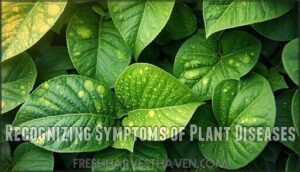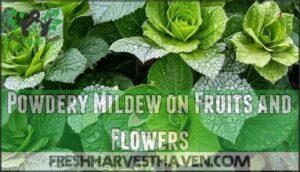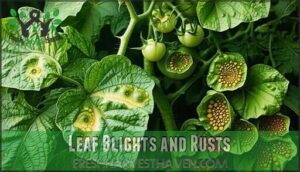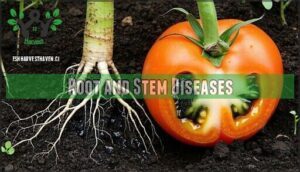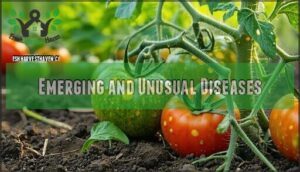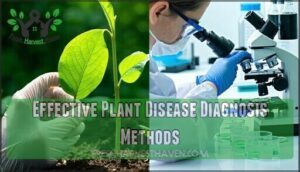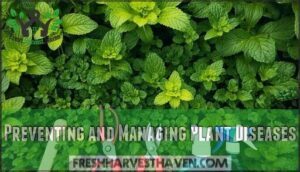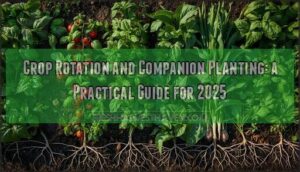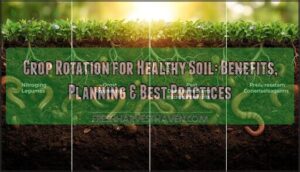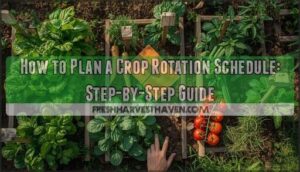This site is supported by our readers. We may earn a commission, at no cost to you, if you purchase through links.
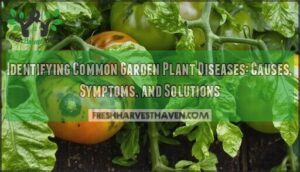
Fungal spores, bacterial infections, and viral pathogens don’t announce themselves with flashing lights, yet learning to spot their subtle signatures can mean the difference between a thriving harvest and a compost pile of failures. Once you know what leaf spots, wilting patterns, and suspicious mold growths actually signal, you’ll catch problems when they’re still manageable—and understand exactly how to respond.
Table Of Contents
- Key Takeaways
- What Causes Garden Plant Diseases?
- Recognizing Symptoms of Plant Diseases
- Identifying Common Garden Plant Diseases
- Effective Plant Disease Diagnosis Methods
- Preventing and Managing Plant Diseases
- Frequently Asked Questions (FAQs)
- How do I find out what disease my plant has?
- What environmental factors worsen plant diseases?
- How does soil pH affect disease development?
- When should diseased plants be removed completely?
- Can plant diseases spread to nearby gardens?
- Which seasons have highest disease risk?
- How do I sterilize tools between plants?
- Can diseased plants recover without treatment?
- What diseases spread through contaminated water?
- How long do fungal spores survive?
- Conclusion
Key Takeaways
- Early identification of plant diseases through visual symptoms like leaf spots, wilting, and mold growth lets you intervene before infections become unmanageable, with systematic inspection catching problems when they’re still treatable.
- Fungal, bacterial, and viral pathogens each display distinct signatures—fungal issues produce spores and rot, bacterial infections create oozing and streaking, while viral diseases cause twisting and stunting—requiring different treatment approaches.
- Prevention through cultural practices delivers better results than reactive treatment, including proper spacing for air circulation, soil-level watering to keep foliage dry, removing infected debris promptly, and selecting disease-resistant varieties suited to your climate.
- Integrated pest and disease management combining multiple tactics like crop rotation, biological controls, and selective treatments reduces chemical use by up to 95% while maintaining yields, with an average 8:1 benefit-to-cost ratio for growers who adopt these strategies.
What Causes Garden Plant Diseases?
Plenty of things can throw your garden off balance, from invisible microbes to weather that just won’t cooperate.
Knowing what triggers these issues helps you keep your plants healthy. Here’s how disease typically starts in a garden.
Fungal, Bacterial, and Viral Pathogens
When curious leaf spots or wilting suddenly show up in your garden beds, it’s often these invisible troublemakers—fungal, bacterial, and viral pathogens—working behind the scenes. Recognizing Plant Pathogens is key to early Pathogen Identification. Each relies on unique strategies:
- Fungal Biology triggers spores and rot,
- Bacterial Infections ooze and streak,
- Viral Replication twists or stunts.
Environmental Factors and Stress
Just as unseen microbes can wreak havoc, everyday stressors like heat, drought, or crowded roots quietly set your garden up for trouble, too.
Weather extremes, poor soil health, or air pollution chip away at plant defenses. Water stress and nutrient deficiency often trigger abiotic diseases, making plants more vulnerable.
Watch for subtle plant disease symptoms—early signs make disease management much easier.
Role of Insect and Non-Insect Pests
Pests don’t just chew leaves—they often deliver disease straight to your plants, turning minor damage into major infection. Aphids, thrips, and other insect pests act as pest vectors, spreading viral and bacterial plant diseases as they feed. Even noninsect pests like slugs can carry pathogens on their bodies.
Watch for pest damage paired with discoloration or wilting—that’s disease spread in action. Encouraging beneficial insects and using integrated control helps you tackle both common garden pests and the infections they carry.
Disease Transmission in Gardens
Once pests arrive, they rarely work alone—they set the stage for pathogens to follow, using wind, water, soil, and even your gardening tools as highways of infection. Vector spread by insects carries viruses between plants, while water splash propels fungal spores from soil contamination to healthy foliage.
Air currents distribute pathogens across your garden, and seed transmission can introduce disease before you even plant.
Good garden hygiene—removing plant debris and disinfecting tools—disrupts these transmission routes effectively.
Recognizing Symptoms of Plant Diseases
Spotting disease early can mean the difference between saving a plant and losing it entirely. You’ll need to know what healthy growth looks like before you can recognize when something’s wrong.
Here’s what to watch for when trouble’s brewing.
Common Visual Signs (Spots, Wilting, Mold)
When something’s wrong with your plants, they’ll usually tell you—through telltale spots on their leaves, sudden wilting, or fuzzy mold creeping across stems and buds. These visual cues help you pinpoint fungal disease, bacterial infections, or stress-related issues. Symptom timing matters too—recognizing early signs speeds up effective treatment.
Watch for these common plant disease symptoms:
- Leaf spots – circular, angular, or irregular discoloration in black, brown, yellow, or rust tones
- Wilting – drooping foliage despite adequate watering, often signaling root or vascular problems
- Mold growth – white powdery coating or gray fuzzy patches on leaves, stems, or flowers
- Yellowing leaves – chlorosis that spreads from older to newer growth, indicating nutrient deficiency or infection
- Stunted growth – reduced vigor, distorted shoots, or premature leaf drop without obvious cause
Differentiating Disease Vs. Pest Damage
Not all damage you see in the garden comes from disease—sometimes the culprit is chewing, sucking, or tunneling through your plants instead. Pest feeding leaves behind ragged holes, skeletonized leaves, or sticky residue, while plant diseases create uniform spots or mold.
Look for insect evidence like frass presence or visible bugs. Disease symptoms spread in patterns without physical tears, though insect problems often introduce disease vectors that complicate plant disease identification during pest outbreaks.
Disease Progression and Severity
Plant diseases don’t stand still—they advance from a few isolated spots into full-blown infections that can threaten your entire crop if you don’t catch them early.
Infection rate depends on environmental influence like humidity and temperature, which accelerate symptom development.
Plant susceptibility varies by species, so understanding how biotic diseases progress helps you gauge disease impact.
Monitoring disease symptoms closely improves plant disease identification before plant pathogens cause irreversible damage.
Identifying Common Garden Plant Diseases
Once you’ve caught those telltale signs, it’s time to pin down the actual troublemaker. The usual suspects—think black spot and its fungal cousins—are probably familiar, but some newer threats might catch you off guard.
Let’s walk through the key clues that’ll help you nail down what’s really happening in your garden.
Black Spot on Roses and Ornamentals
If you’ve ever noticed those telltale dark circles spreading across your rose leaves like ink stains on silk, you’re dealing with black spot—one of the most persistent fungal foes in ornamental gardening. This fungal disease causes infected leaves to yellow and drop, leading to rose defoliation that weakens your plants.
Spores overwinter in fallen debris, so removing infected material is key. Preventative sprays and resistant varieties offer your best defense against this stubborn pathogen.
Powdery Mildew on Fruits and Flowers
Powdery mildew looks harmless at first—like someone dusted your plants with flour—but this deceptively soft coating can quickly suffocate leaves, stunt growth, and ruin your harvest if you don’t catch it early. This fungal disease thrives when humidity’s high but soil stays dry.
Here’s how to tackle it:
- Improve air circulation by spacing plants properly and pruning dense growth
- Water at soil level with a soaker hose to keep foliage dry
- Apply organic fungicides like neem oil or sulfur sprays at first signs
- Choose resistant varieties when planting susceptible fruits and flowers
Remove infected debris promptly to prevent spores from overwintering in your garden.
Leaf Blights and Rusts
Blights and rusts sweep through gardens like wildfires, turning healthy foliage into a patchwork of dead tissue and rusty pustules almost overnight.
Blight prevention starts with host specificity awareness—tomato blight won’t jump to your beans. Rust identification is simple: look for orange or brown powdery spots on leaf undersides.
Treatment options include copper-based fungicides and removing infected leaves immediately to stop fungal spread before it devastates your entire crop.
Root and Stem Diseases
While foliar diseases grab your attention with their obvious symptoms, the real killers often work silently underground, rotting roots and stems until your plants collapse without warning.
Root rot and vascular wilts thrive in waterlogged soil, choking off nutrient flow. Watch for these disease symptoms:
- Blackened, mushy roots with foul odor
- Stem canker causing sunken, dark lesions
- Sudden wilting despite adequate water
- Crown gall tumors at soil line
Plant disease identification requires digging below the surface—literally.
Emerging and Unusual Diseases
Beyond familiar threats, you’re now facing a wave of new enemies. Phytoplasma expansion hit 25 additional ornamental species in 2025, with detection rates jumping 38% in the Midwest due to leafhopper surges. Novel fungal traits, like Neopestalotiopsis fruit rot devastating strawberry nurseries across seven states, caught growers off guard. Bacterial infections from Xanthomonas affected 32% of pepper and tomato gardens during summer heat events.
These invasive complexes and climate impacts—flooding, drought stress, extreme humidity—are rewriting the rulebook for plant disease identification, forcing you to recognize unfamiliar disease symptoms from evolving plant pathogens. Summer heat and humidity create ideal conditions for fungal and bacterial growth.
Effective Plant Disease Diagnosis Methods
Spotting plant diseases early can save your garden from serious trouble.
The key is knowing when you can diagnose the problem yourself and when it’s time to bring in an expert.
Let’s walk through the two main approaches to diagnosing what’s affecting your plants.
Visual Inspection Techniques
Catching plant disease early starts with knowing what to look for, and a systematic visual check of your plants can reveal telltale signs before trouble spreads.
Start with leaf symptom analysis—examine both upper and lower surfaces for spots, discoloration, or unusual textures. Use a hand lens to catch early disease signs like tiny spores or subtle color changes.
Don’t skip stem abnormality checks; look for cankers, lesions, or oozing sap. Root examination tips include gently uncovering the base to check for rot or discoloration.
Pay attention to environmental clues too—decode patterns like whether symptoms appear after rain or in shaded areas, helping you identify plant diseases more accurately.
When to Seek Expert Help
Sometimes visual inspection won’t cut it, and that’s when expert help becomes necessary. You should contact a diagnostic lab or plant pathologist when disease symptoms cover more than 25% of leaf area or spread rapidly across multiple plants within 48 hours.
Professional input is especially important when:
- Initial treatments fail to stop progression within seven days
- Symptoms suggest mixed infection or regulatory concerns
- Diagnostic accuracy matters for high-value or rare specimens
Laboratory services generally cost $30 to $60, with turnaround in 7-10 business days. Modern technology adoption, including AI-powered triage apps, helps determine severity thresholds before submission. Accurate and timely results from molecular techniques enable prompt management decisions.
Proper pathogen identification through expert disease management ensures you’re not misdiagnosing abiotic stress as infection—a mistake made in over 22% of cases—and provides targeted plant disease identification and control strategies. Reporting protocols require photos, symptom notes, and recent care history for accurate assessment, minimizing financial implications of incorrect treatment while supporting effective disease management.
Preventing and Managing Plant Diseases
Armed with the right diagnosis, you can tackle disease head-on—or better yet, stop it before it starts.
Prevention beats treatment every time, and your best bet is pairing good gardening habits with smart, targeted solutions.
Here’s how to keep your garden healthy year-round.
Cultural and Organic Control Practices
The best defense against plant disease isn’t a spray bottle—it’s how you care for your garden day in and day out.
Start by building soil health with compost and organic matter. Choose resistant varieties suited to your climate, and try companion planting to naturally discourage pathogens.
Prune with clean tools to boost air circulation, and use organic bio fungicides or natural sprays sparingly. These organic gardening practices form the backbone of effective plant health management and disease prevention.
Fungicide and Chemical Applications
If natural remedies aren’t cutting it, fungicides might be your next move—but they’ll only work if you pick the right one and use it properly. Here’s the breakdown:
- Match the fungicide to the disease—copper-based products work well for bacterial issues, while sulfur targets powdery mildew.
- Time your application early, before symptoms spread, and follow label instructions to avoid chemical resistance.
- Protect yourself and beneficial insects by wearing gloves and spraying during calm, cooler hours to minimize environmental impact.
Integrated Pest and Disease Management
By combining multiple tactics—like biological control, crop rotation, and selective pesticide use—you create a defense system that’s both resilient and cost-effective. Integrated pest management delivers environmental benefits through lower chemical exposure and improved soil health, plus economic impacts averaging an 8:1 benefit-cost ratio.
Currently, 37% of vegetable growers worldwide have adopted IPM strategies, reducing insecticide applications by up to 95% while maintaining yields.
Despite these advantages, adoption barriers like limited awareness and resources still slow uptake of these disease management strategies for effective disease control and identifying plant diseases before they spread.
Best Practices for Healthy Gardens
A thriving garden isn’t luck—it’s what happens when you tackle problems before they take root. Here’s how to keep your plants healthy:
- Soil health and plant selection: Build well-drained soil with organic matter, and choose disease-resistant varieties suited to your climate for natural defenses.
- Watering techniques: Use soaker hoses instead of overhead watering to keep foliage dry and reduce infection risk.
- Garden hygiene: Remove infected debris promptly, disinfect pruners between cuts, and maintain proper spacing for air circulation—essential preventative care for long-term plant disease prevention.
Frequently Asked Questions (FAQs)
How do I find out what disease my plant has?
Start with a symptom photo guide or online disease checkers to narrow possibilities.
Local extension services offer plant disease identification and control expertise, while diagnostic lab tests provide microscopic identification of plant pathogens when visual inspection isn’t enough.
What environmental factors worsen plant diseases?
Wet weather and humid conditions create an ideal environment for fungal spores to germinate and spread. Poor air circulation traps moisture around foliage, while inadequate soil drainage leads to waterlogged roots.
Temperature stress weakens your plants’ natural defenses, and excessive or insufficient sunlight exposure disrupts normal growth.
Plant debris harbors pathogens that reinfect healthy tissue.
How does soil pH affect disease development?
Soil pH influences disease development by affecting nutrient availability and pathogen activity. Extreme pH levels stress plants, increasing disease susceptibility.
You’ll want to test your soil and adjust pH with amendments to maintain suitable ranges for plant health and minimize abiotic diseases.
When should diseased plants be removed completely?
Remove diseased plants immediately if contagion risk is high, treatment failure persists, or plant pathogens threaten nearby vegetation.
Fungal disease and aesthetic impact also warrant removal to protect your garden’s health and maintain effective disease control.
Can plant diseases spread to nearby gardens?
Yes, plant diseases absolutely can jump fences. Windborne pathogen dispersal carries fungal spores and bacteria across yards, while shared soil concerns arise from contaminated tools, water runoff, and insect vectors moving between properties.
Community disease control through collective prevention practices protects entire neighborhoods from common plant diseases.
Which seasons have highest disease risk?
Spring and fall bring the highest disease risk because fungal disease thrives in wet weather and humid conditions.
Temperature effects and humidity levels create ideal environments for common plant diseases, with regional variations influencing seasonal disease prevalence patterns.
How do I sterilize tools between plants?
Think of your pruners as surgical instruments—cross-contamination spreads disease just as easily in the garden.
You’ll want to disinfect tools between plants using rubbing alcohol, diluted bleach (one part to nine parts water), or commercial disinfectants, letting them dry before the next cut to guarantee effective sterilization and disease prevention.
Can diseased plants recover without treatment?
Some plants can bounce back on their own if the disease is mild and conditions improve, but recovery factors like plant immunity, environmental impact, and the disease type matter.
Without treating plant diseases, long-term viability often suffers, especially with fungal disease treatment needs.
What diseases spread through contaminated water?
Waterborne pathogen spread occurs when irrigation water sources carry fungal disease spores or plant pathogens. Preventing splash dispersal through drip irrigation instead of overhead watering reduces root rot and improves soil drainage.
Water quality testing helps with disease vector control.
How long do fungal spores survive?
Fungal spores can survive from several months to years, depending on the species and conditions. Most plant pathogens remain viable for one to two years in debris or soil, though some persist longer in dormant states.
Conclusion
Like a detective learning to read fingerprints, you’ve now gained the skill of identifying common garden plant diseases before they steal your harvest. Those cryptic leaf spots, telltale molds, and wilting stems won’t slip past you anymore—you’ll recognize the patterns, understand the causes, and respond with precision.
You’ve learned to spot garden diseases before they destroy your plants—recognizing patterns, understanding causes, and responding with precision
Armed with visual inspection techniques and preventive strategies, you’re no longer guessing in the dark. Your garden’s health depends on vigilance, and now you’ve got the expertise to protect it.
- https://www.rhs.org.uk/science/articles/2023-diseases
- https://apsjournals.apsnet.org/doi/10.1094/PHYTO-04-24-0137-KC
- https://pmc.ncbi.nlm.nih.gov/articles/PMC5247434/
- https://www.sciencedirect.com/topics/agricultural-and-biological-sciences/bacterial-diseases-of-plants
- https://www.pnas.org/doi/10.1073/pnas.2022239118

